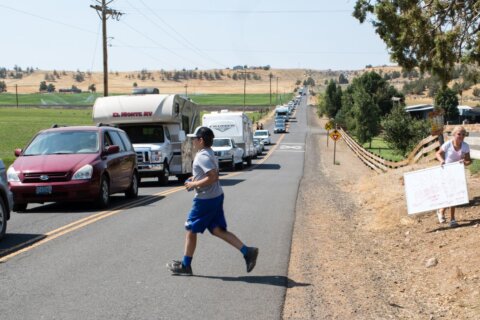WASHINGTON — As the District of Columbia faces a significant drop off on speed camera tickets during FY 2014, there are questions as to what happened and why.
A Washington Post article last week suggested that poor maintenance and weather were to blame.
But sources tell WTOP that the overall impact of the winter on the drop in speed camera tickets was minimal. Some speed cameras were inaccessible during the snow, but several speed camera experts across the region pointed out that during snowstorms and the immediate aftermath, people are not speeding because of conditions.
In the Chief Financial Officer’s report in December 2014, Jeffrey S. DeWitt does not mention maintenance as an issue.
“Implementation delays of ATE (automated traffic enforcement cameras) initiatives cost the District almost $40 million in lost traffic fines revenue in FY 2014. The number of ticket issuances in FY 2014 plummeted by more than 50 percent from FY 2013 and FY 2012, averaging only 30,000 per month, compared to almost 70,000 in FY 2012 and reaching lows of just 10,000 per month in the early part of FY 2014,” writes DeWitt.
Sources tell WTOP that poor maintenance was not a factor. While DC Police do maintain the newer cameras in the city, contractor American Traffic Solutions (ATS) still own and maintain a significant portion of the cameras as well. When speed cameras in Maryland were moved back into Washington, D.C. in August 2014, it was ATS and not D.C. Police who did the work.
“These are staggering numbers and also mind-boggling figures. How can you account for that? It can’t be because of mechanical malfunctions. I don’t think that it has anything to do with the weather. Something went on here, but we may never know what it is,” says John B. Townsend II, AAA Mid-Atlantic’s manager of public and government affairs.
D.C. Police say the overall drop is because drivers aren’t speeding, or at least not by the cameras.
“As to the loss of revenue because people are complying with the law, I say ‘Hallelujah.’ That’s the very purpose of it. It’s not supposed to be a revenue raiser. It’s supposed to be an enforcement mechanism, first and foremost,” says Councilmember Mary Cheh, who chairs the Transportation and the Environment Committee.
Others point out that apps like Waze, TomTom and others alert drivers to speed cameras before approaching them. Thus, people slow down and then speed up again when they get past the camera.
“Motorists are better informed and that means governments are foolhardy if they build budgets around speed camera revenue because they always are going to drop,” says Townsend.
Another reason was the DDOT Safety Nexus study released in January 2014. While DDOT and Parsons Brinckerhoff were conducting the study, D.C. Police were not permitted to move the cameras around the city. Statistics throughout the region show that the longer speed cameras remain at one location, the less effective they are. Speed camera experts explain that people know the location, slow down or take another route.
Implementation delays also played a role, as the CFO noted in the December report. Those had to do with the blocking the box and pedestrian crosswalk cameras. Sources tell WTOP that it took longer than expected to deploy the cameras. In order to do it, DDOT and D.C. Police had to sign off on paperwork.
“The previous forecast for FY 2015 assumed a full roll-out of all new ATE equipment by the beginning of the fiscal year (Oct. 1). This has yet to occur, and it will compound the shortfall in traffic fines revenue in FY 2015,” writes DeWitt.
“Revenues in FY 2015 are lower by $78 million, recovering slightly in FY 2016. The reduced forecast is still predicated on a full implementation of all ATE initiatives by April of 2015,” he concludes.
“I’m a little disappointed that it was because of non-implementation. I would have liked it all to have been compliance with the laws,” says Cheh.
Police reported the number of pedestrian fatalities fell from 12 in 2013 to 10 in 2014. However, as WTOP has reported, pedestrian fatalities are going up overall in the region.







